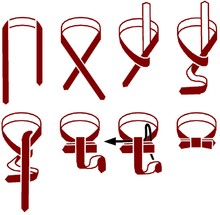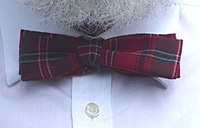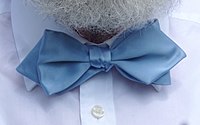Bow tie

The bow tie or dicky bow
There are generally three types of bow ties: the pre-tied, the clip-on, and the self-tie. Pre-tied bow ties are ties in which the distinctive bow is sewn onto a band that goes around the neck and clips to secure. Some "clip-ons" dispense with the band altogether, instead clipping straight to the collar. The traditional bow tie, consisting of a strip of cloth that the wearer has to tie by hand, is also known as a "self-tie", "tie-it-yourself", or "freestyle" bow tie.
Bow ties may be made of any fabric material, but most are made from
Origin and history

The bow tie originated among
The most traditional bow ties are usually of a fixed length and are made for a specific size neck. Sizes can vary between approximately 14 inches (36 cm) and 19 inches (48 cm) as with a comparable shirt collar. Fixed-length bow ties are preferred when worn with the most formal wing-collar shirts, so as not to expose the buckle or clasp of an adjustable bow tie. Adjustable bow ties are the standard when the tie is to be worn with a less formal, lie-down collar shirt that obscures the neckband of the tie. "One-size-fits-all" adjustable bow ties are a later invention that helps to moderate production costs.
The
Wearers
To its devotees, the bow tie suggests iconoclasm of an Old World sort, a fusty adherence to a contrarian point of view. The bow tie hints at intellectualism, real or feigned, and sometimes suggests technical acumen, perhaps because it is so hard to tie. Bow ties are worn by magicians, country doctors, lawyers and professors and by people hoping to look like the above. But perhaps most of all, wearing a bow tie is a way of broadcasting an aggressive lack of concern for what other people think.
— Warren St John in The New York Times, 2005[2]

Popular perception tends to associate bow tie wearers with particular
Bow ties, or slight variations thereof, have also made their way into women's wear, especially business attire. The 1980s saw professional women, especially in law, banking, and the corporate world, donning very conservative tailored suits, with a rise of almost 6 million units in sales.[5] These were often worn with buttoned-up blouses, some with pleats up the front like tuxedo shirts, and accessorized with bow ties that were slightly fuller than the standard bow ties worn by their male counterparts, but typically consisting of the same fabrics, colors, and patterns as men's ties.[citation needed]
Types
Self-tie
There are usually two shapes of self-the bow ties available: the "bat wing", which is parallel-sided like a cricket bat, and the "thistle", also known as the "butterfly". An example of each can also be seen below. Which is worn is a matter of personal preference. Some other shapes do exist; for instance, the Diamond Point, with pointed tips at both ends. This is a double-ended type, with both ends shaped, though occasionally, ties are tied in the single-ended type, in which only one end flares out to give the batwing or thistle shape, and the other remains thin. To tie one of these requires careful consideration, to ensure the broader end finishes in front of the thinner one.
- Self-Tie Bows
-
Silk bow ties. Fixed length with "thistle" ends (left) and adjustable with "bat wing" ends (right).
-
Bright Yellow patterned self-tie bow tie, made of cotton, designed and made in the UK
-
Bow tie, type Butterfly, silk
-
Bow tie, type Batwing, wool
-
Bow tie, type Diamond Point, silk
Pre-tie
Shown below on the right is one style of pre-tie/ready-tie bow tie. Wearing a ready-tied bow tie at formal occasions requiring a black or white tie dress code is usually considered a faux pas, though at occasions such as Schools Leavers' Proms or ones at which the participants are unlikely to have had much experience wearing bow ties, it may be commonplace.
As shown in the pictures below, another type of ready-tie bow tie is the wooden bow tie, a fairly new product made mostly in the U.S and Canada. Other materials are also in use. An example would be bow ties that are made of natural bird feathers; this too is a fairly new product made mostly in the U.S. and Europe (in Poland).
- Pre-Tie Bows
-
A pre-tied bow tie
-
Informal bow tie
-
Wooden bow tie, made in Canada and U.S
-
Bow tie made of feathers, made in Poland
Clip-on
A clip-on does not go around the neck but clips to the collar points.
Gallery
-
Johan Krouthén wearing a bow tie.
-
Jim Rogers, wearing a bow tie in 2010.
-
Elio Di Rupo, former Prime Minister of Belgium, is a regular wearer of bow ties.
-
his show, wore a powder blue lab coat and bow tie.
-
Paul Reubens as Pee-wee Herman wore a trademark red bow tie.
-
Donald Tsang, former Chief Executive of Hong Kong, is well known for wearing bow-ties.
-
Michael Maxey, president of Roanoke College is well known for wearing bow-ties.
-
Tucker Carlson wearing a bow tie in early 2004.
References
- ^ "DICKY BOW definition and meaning". Collins English Dictionary. Glasgow: HarperCollins. Archived from the original on April 12, 2024. Retrieved April 12, 2024.
- ^ St John, Warren (June 26, 2005). "A Red Flag That Comes in Many Colors". The New York Times. Retrieved October 22, 2008.
- ISBN 978-0-9622610-0-8.
- ^ Cook, Joan (February 19, 1988). "The Law; In Celebration of 'Dignified Frivolity'". The New York Times. Retrieved October 22, 2008.
- ^ Euse, Erica (March 21, 2016). "The Revolutionary History of the Pantsuit". Vice.com. Retrieved March 11, 2019.
- ISBN 978-0-312-36165-5.
- ^ a b Smith, Russell (November 15, 2008). "Rock the bow tie without looking nerdy". The Globe and Mail.
Bow ties are tricky. They carry strong connotations: conservative, newspaperman, high-school principal. They are instant signs of nerddom in Hollywood movies. They look fastidious but not exactly sexy.

















